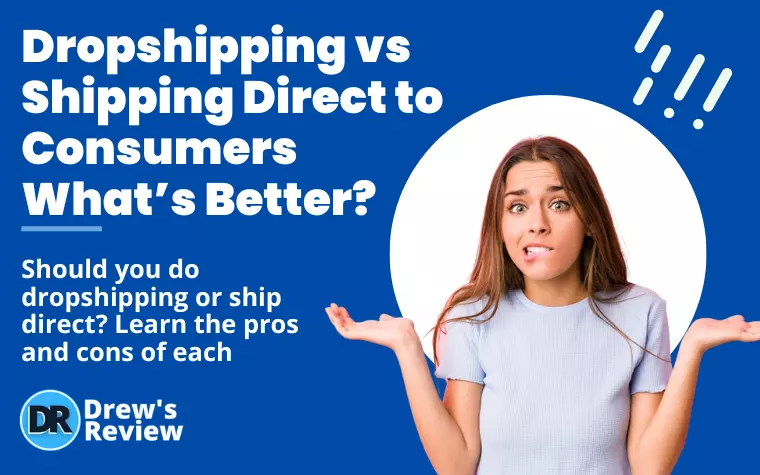
Dropshipping and selling products directly to consumers are two different methods of doing business.
Each has its own set of advantages and disadvantages, which we'll explore in this post. By the end, you should have a good idea of which option is best for you. Let's get started!
Main Differences Between Dropshipping and Selling Direct
Dropshipping is an outsourcing model where online stores outsource the logistics process. Retailers do not keep inventory themselves; rather, they contract with vendors to fulfill orders. This allows eCommerce businesses to focus on what they are best at—creating products and marketing campaigns.
In a direct shipping model, companies keep all inventory and fulfill orders themselves. They maintain control over pricing and product availability. However, it takes up more resources, as well as space, and can increase operating expenses.
Both models require different strategies to work effectively. A drop shipper doesn’t have to worry about inventory management or fulfillment costs. But direct shipping involves additional investments in terms of capital and labor.
Is Dropshipping Better Than Direct Shipping?
Dropshipping is often touted as being easier than direct shipping. And in some ways, it is. Retailers don’t need to worry about inventory management, and they can get started without a large up-front investment.
However, dropshipping also has its challenges. Because retailers don’t control the fulfillment process, they can run into issues with late shipments or out-of-stock items. In addition, margins can be slim because of the competition among dropshippers.
Direct shipping is a more traditional model, but it comes with its own set of advantages and disadvantages. On the plus side, businesses have more control over their inventory and can offer better customer service. But direct shipping requires a larger up-front investment and more resources to manage effectively.
So which model is better?
It depends on your business goals and resources. If you’re looking for a low-cost way to get started in eCommerce, dropshipping might be the best option. But if you want more control over your business, direct shipping may be a better choice.
Dropshipping Pros
Here are some pros/advantages of dropshipping to consider.
Low Overhead Costs
When starting a dropshipping store, the initial investment is quite low. You will need to pay for hosting, a domain name, an eCommerce platform, and other necessary tools and resources. For those on a budget, this can be a great way to get started with eCommerce. Get more details on expenses here.
No Need to Carry Inventory
One of the biggest advantages of dropshipping is that you don’t need to carry inventory. This means there’s no risk of being stuck with products that don’t sell. And, if a product is out of stock, you can simply remove it from your store until it’s available again.
You Can Sell Worldwide
Another advantage of dropshipping is that it’s not location-dependent. You can run your business from anywhere in the world as long as you have an internet connection. This makes it a great option for entrepreneurs who want the freedom to work from anywhere.
Dropshipping Cons
Lower Margins
One of the biggest challenges of dropshipping is that margins can be quite low. This is because there’s a lot of competition among dropshippers. In addition, you have to factor in the cost of shipping and other fees charged by your supplier. As a result, you need to ensure you are making a decent enough profit with your markup.
Lack of Control Over Inventory and Shipping
Another downside to dropshipping is that you don’t have much control over inventory or shipping. Because you’re relying on a third-party supplier, issues like late shipments or out-of-stock items are beyond your control. This can lead to frustrated customers and a negative impact on your business.
Competition
Dropshipping can be a great way to get started in eCommerce. However, it’s important to be aware of the competition. Because margins can be slim, there are a lot of businesses dropshipping similar products. This can make it difficult to stand out from the crowd.
To succeed with dropshipping, you need to find a niche market and build a brand that resonates with your target audience. If you can do this, you’ll be more likely to succeed despite the competition.
Direct Shipping Pros
More Control Over Inventory
One of the biggest advantages of direct shipping is that businesses have more control over their inventory. This means you can avoid issues like stockouts and backorders. In addition, you can better manage your inventory levels to avoid excess storage costs.
Better Customer Service
Another advantage of direct shipping is that it allows businesses to offer better customer service. Because you’re in control of the shipping process, you can provide accurate information to customers and resolve issues more quickly. This can lead to happier customers and repeat business.
Higher Margins
Due to the increased control over inventory and shipping, businesses tend to have higher margins with direct shipping. When buying products in bulk, they are typically much cheaper than buying single items which is what you do with dropshipping. So, your profits are much higher.
Direct Shipping Cons
Requires a Larger Up-Front Investment
One of the biggest disadvantages of direct shipping is that it requires a larger up-front investment. This is because businesses need to carry inventory and manage the shipping process. You'll also need storage space for your items. If they aren't too big, you could probably store them in your house. Larger items might require a garage or possibly renting storage space.
You don't have to have a warehouse, and renting a storage locker comes pretty cheap when comparing it to warehousing costs.
More Complex Business Model
Another downside of direct shipping is that it’s a more complex business model. Because businesses need to manage inventory and shipping, there are more moving parts to keep track of. This can make it difficult to scale and grow your business for those just starting out.
Risk of Excess Inventory
One of the biggest risks of direct shipping is that businesses can end up with excess inventory. This can happen if demand for a product suddenly drops or if sales are slower than expected. As a result, businesses may have to sell products at a discount.
So, What’s the Verdict?
Dropshipping is great for businesses that are just starting out or don't have a lot of money to invest while selling direct to consumers is better for businesses that want more control over their brand and pricing.
When it comes to starting a new business, there are often many different factors to consider.
For example, if your company has limited resources or is just getting started, you may want to look into dropshipping as a way to manage your inventory costs and minimize upfront investment.
On the other hand, if you are more concerned with having complete control over your brand and pricing structures, selling direct to consumers may be a better option.
Whether dropshipping or selling direct is right for your business depends on a number of different factors, including your budget, goals, and industry. But whichever route you choose, just be sure to do your research and carefully consider all of the options before diving in headfirst.
The Best Way to Start Your Online Store - Use Dropshipping AND Direct Shipping
One of the best ways to get started during these times is to test the market with dropshipping first. You can do this by setting up a Shopify store and finding products that you can dropship. When you find a few winners, you can move to a wholesale model where you buy these products in bulk and then sell direct.
The advantage here is more profit and much quicker shipping times. This is the new way to do dropshipping. The old-style method just doesn't work anymore.
To learn this new style of dropshipping, I suggest you take the eCommerce Accelerator course. It's taught by a 7 figure earner that employs this exact strategy. You'll learn how to duplicate what she does and have the best chance of succeeding.
No matter what route you decide to take, the most important thing is to just get started. The sooner you take action, the sooner you'll see results. I have the course myself and by following it I was able to successfully wholesale my first product. I wish I had done this before with my "winners" as it is just so much more profitable.
Want to learn how the eCommerce Accelerator works? See my eCommerce Accelerator review here.
Conclusion
So, which is the best option for you? Dropshipping or selling direct to consumers? The answer depends on your business goals and what you’re willing to invest.
If you want to start a business with low overhead costs and don’t mind not having as much control over your brand, then dropshipping is the way to go. But if you want more freedom over your pricing and branding, selling directly to consumers is a better option.
If starting with dropshipping, ensure that you move to a wholesale or "direct to consumer" model with your winning products if you want to survive in this thriving industry.
Related Articles
- Best Ways to Make Passive Income on YouTube - April 15, 2024
- How I Make Faceless YouTube Channels With AI - April 9, 2024
- Top 21 Faceless YouTube Niches to Earn Big Profits in 2024 - April 3, 2024

